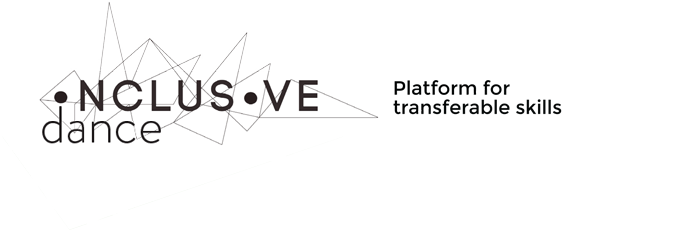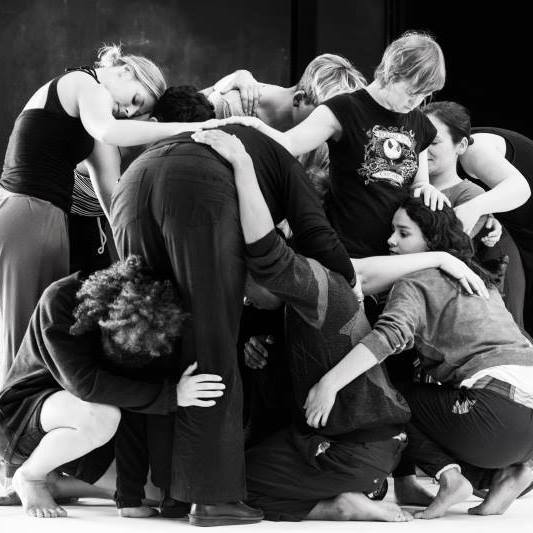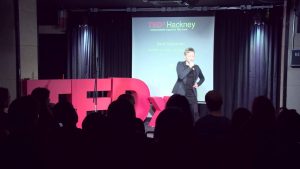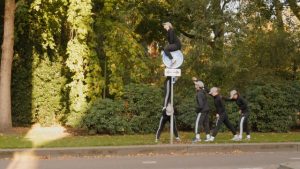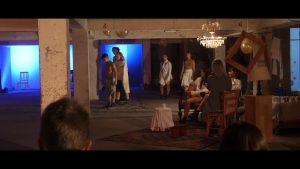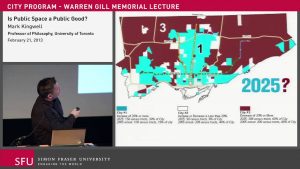1
“Making an Entrance”
Author: Adam Benjamin
A practical and provoking introduction to teaching dance with disabled and non-disabled dancers which contains two episodes. The theoretical part explores the history of a disintegrated dance practice and questions what we expect of inclusive/integrated dance. The second part takes improvisation as focus and includes different exercises for choreographic exploration.
“Inclusive Arts Practice and Research: A Critical Manifesto”
Authors: Alice Fox, Hannah Macpherson
Inclusive Arts Practice and Research interrogates an exciting and newly emergent field: the creative collaborations between learning-disabled and non-learning-disabled artists which are increasingly taking place in performance and the visual arts. The book includes interviews, essays and illustrated statements.
“It’s your move : an inclusive approach to dance”
Author: Peppy Hills
Author Peppy Hills has more than 15 years of experience as a community dance artist. It’s your move is a combined theoretical and practical approach including examples that will lead to inclusive dance sessions. The book challenges conventional views of ‘dancers’ and ‘dancing’ and explores the creative possibilities that makes dance accessible and exciting for everyone.
“Inclusive Dance Resource Pack”
StopGap Dance Company
The resource pack provides dance facilitators with practical guidance for delivering community dance workshops that are inclusive for disabled and non-disabled people. Stopgap makes dance in the community inclusive by responding and adapting to the individuals in any given dance session.
” ‘We’re People Who Do Shows’: Back to Back Theatre – Performance, Politics, Visibility (Inside Performance Practice Series)”
Editors: Helena Grehan, Peter Eckersall
This book gathers key perspectives on Back to Back Theatre including interviews, documentation and scripts here made available to the reader for the first time. Accompanying this are essays and artistic reflections on some of the company’s most influential shows, including Soft, small metal objects, Food Court and Ganesh Versus the Third Reich.
“Disability Culture and Community Performance: Find a strange and twisted shape”
Author: Petra Kuppers
This book presents a senior practitioner/critic’s exploration of arts-based research processes sustained over more than a decade – a subtle engagement with disability culture.
“Disability and Contemporary Performance: Bodies on the Edge”
Author: Petra Kuppers
Disability and contemporary performance presents a remarkable challenge to existing assumptions about disability and artistic practice. In particular, it explores where cultural knowledge about disability leaves off, and the lived experience of difference begins. Petra Kuppers investigates the ways in which disabled performers challenge, change and work with current stereotypes through their work.
“Studying Disability Arts and Culture: An Introduction”
Author: Petra Kuppers
In this accessible introduction to the study of Disability Arts and Culture, Petra Kuppers foregrounds themes, artists and theoretical concepts in this diverse field. Complete with case studies, exercises and questions for further study, the book introduces students to the work of disabled artists and their allies, and explores artful responses to living with physical, cognitive, emotional or sensory difference.
“Community Performance: An Introduction (Volume 1)”
Author: Petra Kuppers
Community Performance: An Introduction is a comprehensive and accessible practice-based primer for students and practitioners of community arts, dance and theatre. Petra Kuppers has drawn on her vast personal experience and a wealth of inspiring case studies to create a book that will engage and help to develop the reflective community arts practitioner.
“The Community Performance Reader (Volume 2)”
Editors: Petra Kuppers, Gwen Robertson
The book brings together core writings and critical approaches to community performance work, presenting practices in the UK, USA, Australia and beyond. It offers a comprehensive anthology of key writings in the vibrant field of community performance, spanning dance, theatre and visual practices.
“Bodies in Commotion: Disability and Performance (Corporealities: Discourses Of Disability)”
Authors: Carrie Sandahl, Philip Auslander
This groundbreaking book imagines disabled bodies as “bodies in commotion” – bodies that dance across artistic and discursive boundaries, challenging our understanding of both disability and performance. In the book’s essays, leading critics and artists explore topics that range from theater and dance to multi-media performance art.
“Disability Aesthetics (Corporealities: Discourses Of Disability)”
Author: Tobin Anthony Siebers
Disability Aesthetics is the first attempt to theorize the representation of disability in modern art and visual culture. It ambitiously redefines both ‘disability’ and ‘aesthetics,’ showing us that disability is central not only to modern art but also to the way we apprehend (and interact with) bodies and buildings.
“Strength: Broadsides from Disability on the Arts”
Author: Paddy Masefield
This remarkable book is the first to focus on disability arts. Drawn from over 50 of the author’s speeches, it offers readers the excitement and diversity of Disability Arts and the artistic expression of formerly excluded sectors of society.
“An Introduction to Community Dance Practice”
Author: Diane Amans
This introductory textbook is aimed at undergraduates studying community dance. Drawing on high profile contributors, the book is packed with case studies, interviews and examples that students can use to explore issues in contemporary dance practice. A resources section includes session plans, evaluation tools and questionnaires.
“Choreographing Difference: The Body and Identity in Contemporary Dance”
Author: Ann Cooper Albright
Through her articulated and nuanced analysis of contemporary choreography, Albright shows how the dancing body shifts conventions of representation and provides a critical example of the dialectical relationship between cultures and the bodies that inhabit them. In arguing for the intelligence of bodies, Choreographing Difference is itself a testimonial, giving voice to some important political, moral, and artistic questions of our time.
“Disability Arts Against Exclusion”
Authors: Dan Goodley, Michele C. Moore
The authors make a powerful case for the benefits of people with learning disabilities taking part in performing arts, with particular emphasis on drama and dance. Examples of good practice are set alongside a review of disability arts in the wider context of debates about inclusion and human rights.
“Body Aesthetics”
Editor: Sherri Irvin
The body is a rich object for aesthetic inquiry. We aesthetically assess both our own bodies and those of others, and our felt bodily experiences have aesthetic qualities. The body, whether depicted or actively performing, features centrally in aesthetic experiences of visual art, theatre, dance and sports.
“Freedom to Move: Movement and Dance for People with Intellectual Disabilities”
Authors: Kim Dunphy, Jenny Scott
Freedom to Move is a unique guide offering a wealth of information, practical advice and creative stimuli for teaching dance and movement to people with intellectual disabilities.
“Dancers and communities: a collection of writings about dance as a community art”
Authors: Helen Poynor, Jacqueline Simmonds
The stories in this book illustrate the rich exchange that takes place between dancers and communities. Dance can be an accessible and empowering creative tool for individuals and groups to express their identity, feelings, histories and aspirations.
2
Books which create a broader background for understanding and placing the dance and disability practice in arts culture better:
“Claiming Disability: Knowledge and Identity (Cultural Front)”
Author: Simi Linton
Claiming Disability is the first comprehensive examination of Disability Studies as a field of inquiry. With vivid imagery and numerous examples, Simi Linton explores the divisions society creates – the normal versus the pathological, the competent citizen versus the ward of the state.
“The Art of Disability: A handbook about Disability Representation in Media”
Author: David Proud
Can disability be seen as an art? Why is it important to modern day culture? How can we increase diversity of disability in media? Featuring contributions from leading industry figures the book covers all disciplines and offers practical advice to anyone working with disabled artists.
“Points of Contact: Disability, Art and Culture (Corporealities: Discourses of Disability)”
Editors: Susan Crutchfield, Marcy Epstein
Points of Contact brings together contributions by leading writers, artists, scholars, and critics to provide a remarkably broad and consistently engaging look at the intersection of disability and the arts. The contributions include essays and memoirs by a wide range of disabled and nondisabled writers.
“Disability Rights and Wrongs Revisited”
Author: Tom Shakespeare
Over the last forty years, the field of disability studies has emerged from the political activism of disabled people. In this challenging review of the field, leading disability academic and activist Tom Shakespeare argues that disability research needs a firmer conceptual and empirical footing.
“Arguing about Disability”
Editor: Kristjana Kristiansen
Serie editors: Simo Vehmas, Tom Shakespeare
Arguing About Disability is one of the first books to attempt to bring together philosophy and disability and in so doing examine the complexity of disability. This comprehensive collection explores disability from a range of theoretical perspectives including the ontology of disability – how liberty, justice, equality and disability are linked, as well as ethics and disability – and gives new insights into current debates on disability.
“Concerto for the Left Hand: Disability and the Defamiliar Body”
Author: Michael Davidson
Concerto for the Left Hand is at the cutting edge of the expanding field of disability studies, offering a wide range of essays that investigate the impact of disability across various art forms—including literature, performance, photography, and film. Rather than simply focusing on the ways in which disabled persons are portrayed, Michael Davidson explores how the experience of disability shapes the work of artists and why disability serves as a vital lens through which to interpret modern culture.
